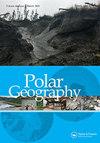Knowledge creation rhythms of a science project, in and beyond remote Ny-Ålesund in the Arctic
IF 1.6
Q3 GEOGRAPHY, PHYSICAL
引用次数: 6
Abstract
ABSTRACT This article discusses how a temporary gathering of researchers in the remote and peripheral Ny-Ålesund research station (78°55’N, 11°54’E) affected the rhythms of knowledge creation in an international research project. Periods of co-presence are crucial for creating knowledge in projects whose members usually work in different geographical locations. Gathering to cities and clusters has been shown to be practical and beneficial, but not enough is known about the meaning of a peripheral place for knowledge creation or how the process continues afterwards. Also, the role of the physical-natural environment for knowledge creation is too little understood. Therefore, in this article, we apply Henri Lefebvre’s rhythmanalysis and its basic concepts (polyrhythmia, eurhythmia, arrhythmia, isorhythmia) to investigate the work of a research group during and after their field campaign in Ny-Ålesund. According to the key results, the gathering in Ny-Ålesund supported an intense and focused eurhythmic ensemble in which rhythms were aligned, the environment became a participant in the knowledge creation process, and a spur in knowledge creation was achieved. However, as the rhythms changed, also the eurhythmia started to dissolve. By zooming in time and space, beyond the gathering, we notice that knowledge is created further through an arrhythmia, an arrhythmia that may also be necessary for achieving innovative scientific knowledge.一个科学项目的知识创造节奏,在遥远的Ny-Ålesund在北极
摘要:本文讨论了一个国际研究项目中,在偏远和外围的Ny-Ålesund研究站(78°55′n, 11°54′e)临时聚集的研究人员如何影响知识创造的节奏。在成员通常在不同地理位置工作的项目中,共同存在的时期对于创造知识至关重要。向城市和集群聚集已被证明是实际和有益的,但对于知识创造的外围场所的意义或之后的过程如何继续,人们知之甚少。此外,人们对物理自然环境在知识创造中的作用了解得太少。因此,在本文中,我们应用Henri Lefebvre的节奏分析及其基本概念(心律失常,心律失常,心律失常,等心律失常)来调查一个研究小组在纽约-Ålesund实地活动期间和之后的工作。根据主要结果,在纽约-Ålesund的聚会支持了一种强烈而集中的韵律合奏,其中节奏是一致的,环境成为知识创造过程的参与者,并实现了知识创造的刺激。然而,随着节奏的改变,心律失常也开始消失。通过放大时间和空间,超越聚会,我们注意到知识是通过心律失常进一步创造的,这种心律失常对于获得创新的科学知识也是必要的。
本文章由计算机程序翻译,如有差异,请以英文原文为准。
求助全文
约1分钟内获得全文
求助全文
来源期刊

Polar Geography
GEOGRAPHY, PHYSICAL-
CiteScore
5.30
自引率
0.00%
发文量
13
期刊介绍:
Polar Geographyis a quarterly publication that offers a venue for scholarly research on the physical and human aspects of the Polar Regions. The journal seeks to address the component interplay of the natural systems, the complex historical, political, economic, cultural, diplomatic, and security issues, and the interchange amongst them. As such, the journal welcomes comparative approaches, critical scholarship, and alternative and disparate perspectives from around the globe. The journal offers scientists a venue for publishing longer papers such as might result from distillation of a thesis, or review papers that place in global context results from coordinated national and international efforts currently underway in both Polar Regions.
 求助内容:
求助内容: 应助结果提醒方式:
应助结果提醒方式:


